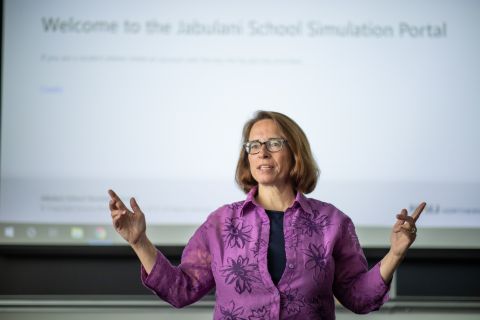As classroom populations become more diverse, the differences in students’ backgrounds have increased the challenge that teachers face to create and deliver effective educational experiences. Research shows that student teachers may master the theory regarding diversity, but they often don’t have the opportunity to apply that theory during their student-teaching experiences. As a result, they may not develop the culturally responsive skills needed to effectively serve children from diverse socioeconomic, racial, ethnic, linguistic and ability/disability backgrounds.
To address this need, Gretchen McAllister, an associate professor in the Department of Teaching and Learning in Northern Arizona University’s College of Education, has created an online simulation environment—the Jabulani School Simulation (JASS)—designed to enable education faculty to create customized classroom simulations for their student teachers to gain hands-on experience with diversity issues. The digital interface simulates teaching in schools by providing online profiles of fictitious students and scenarios to help prepare teachers-in-training for real-life situations focusing on children and families of diverse backgrounds.
Through JASS, teacher candidates go online to apply for a teaching job, get hired and receive their own classes of virtual students. They are tasked with getting to know the students in their classrooms and develop appropriate learning environments, including plans to specifically support their Jabulani students and families.
McAllister said the platform works much like a video game; as participants “level up” in their competencies, they are rewarded with more information that provides deeper insight into an individual student’s background and circumstances. The challenges presented through the simulation are based on research revealing challenges facing teachers and students in classrooms throughout Arizona.
“Through the simulation, teachers will learn to see an educational concept through multiple lenses. For example, a Hopi student’s relationship to the concept of corn and the growing process may be different from a Caucasian child’s,” McAllister said.
“Or we could develop a scenario, for example, in which a second-grader has two dads—one stays at home and one works in construction—and the other kids are curious about this. What could the teacher do to prepare the classroom in subtle ways? What kind of books and pictures are they using to normalize the classroom? Are they in a virtual school that bans LGBTQ literature? How will they work with the principal and the families? Simulating these cases gives teachers a visceral experience and helps build confidence to be more prepared in a real setting.”
McAllister said she discovered the need for such diversity training about 10 years ago.
“I was frustrated with the consistent problem of children of color not performing well in schools. I thought, ‘What if we simulate some of these activities to teach new teachers to help these children feel more comfortable in the learning environment?’ We need to create some space for a community of learners to try and figure this out together, and simulations have been known to help with that.”
The online platform is a series of virtual experiences to help teachers practice their thinking, she says.
“Our future teachers will be student teaching during a semester and will have their own classrooms. But with JASS, they will be set up with profiles of children in their classroom. Those virtual students will provide a learning context for our future teachers to discuss and consider how to best serve them. Jabulani is a place for learning and growth where teacher candidates can make mistakes.”
Turning JASS into a commercially viable product
Meanwhile, Eck Doerry, a professor in NAU’s School of Informatics, Computing, and Cyber Systems, is helping turn McAllister’s virtual Jabulani School into a product that can help teachers everywhere better understand the complexity of today’s classrooms and earn diversity training certification. The product that NAU hopes to bring to market provides two components: a virtual classroom database of students and a series of problem-based learning modules.
“Through JASS, we have the intellectual property,” McAllister said. “What we are looking for now is the funding to have an educational module with a prototype platform up and running.”
“There are teachers in practice and colleges of education that need certification in diversity management,” Doerry said. “Why not turn Jabulani into a classroom marketplace, make it like the Amazon Marketplace of diversity training? Essentially, you have your clients, who are teachers and students in education, and a teacher training program. They could sign up at this site and pay their tuition. Teachers who achieve this level of training could become Jabulani certified across the nation.”
Doerry sees a future where a core of certified Jabulani instructors could be connected with the students going through the curricula and get paid as consultants.
McAllister is hoping to create a community of teachers to serve as mentors and students who will become teachers to help all children have positive experiences in this school.
McAllister and Doerry are working with the NAU Innovations team—the university’s technology transfer arm—to commercialize the simulation as intellectual property. The project is currently in a piloting phase.
If you are a member of NAU faculty or staff, or an NAU student developing any type of technology that may qualify as intellectual property, contact NAU Innovations at nauinnovations@nau.edu or call (928) 523-4620 to discuss how you can protect your intellectual property and possibly develop it for commercialization. Learn more on the NAU Innovations website.
Bonnie Stevens and Kerry Bennett
Office of the Vice President for Research




